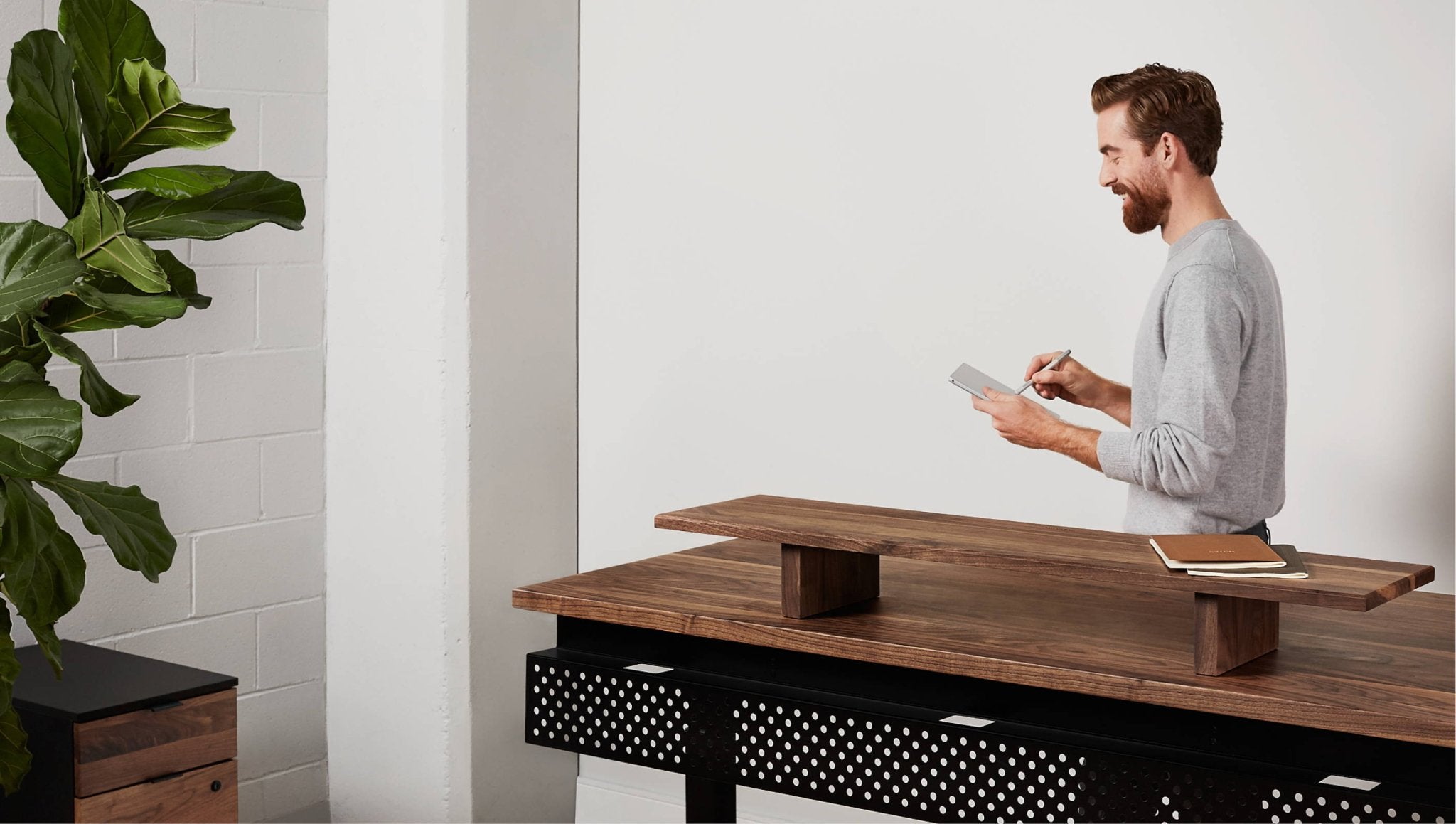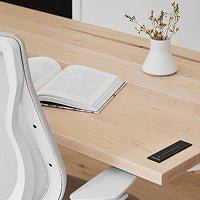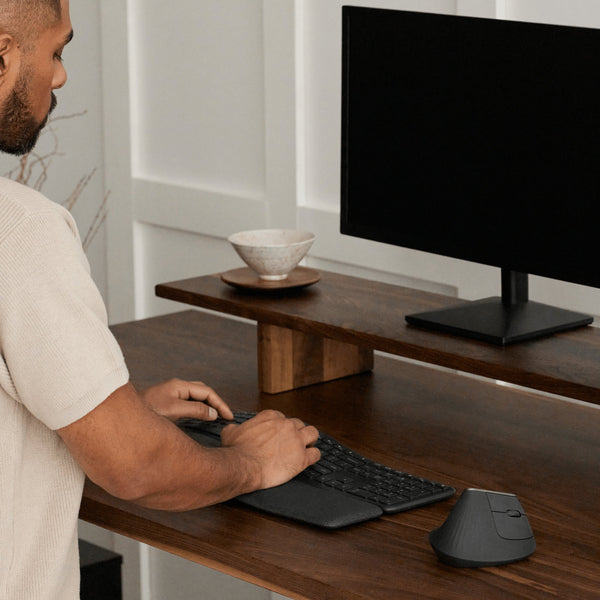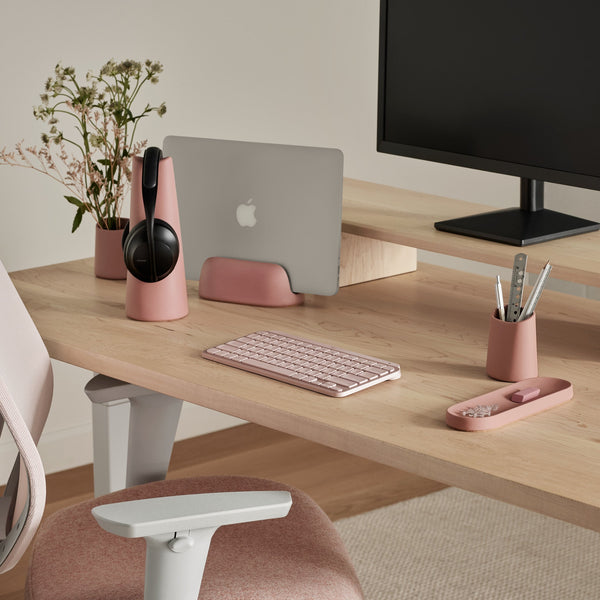In addition to turning everything else in our lives upside down, the COVID-19 pandemic has radically changed our approach to work. No longer happy with a desk job where long hours are spent hunched over a computer, people are taking this opportunity to reevaluate what a work-life balance really means. For some people, that might mean throwing caution to the wind, leaving the office behind, and pursuing their dreams. But for many more people, it’s a lot simpler: they want to be happier, enjoy better overall health, and to just feel better. And spending eight hours a day, five days a week, sitting in an uncomfortable chair, with poor posture, is not the way to feel better.
That’s why this is the perfect moment to rethink our workspaces, and what better place to start than with a standing desk? There's a reason they're all the rage.
What is a standing desk and how do they work ?
Standing desks are work surfaces that can be adjusted to be used in a sitting or standing position. While you’ve probably been hearing a lot more about them recently, they have a long pedigree—Marie-Antoinette even had one. From sitting to standing—that’s why they’re also called sit-stand desks—these desks can be easily adjusted to give your working environment maximum flexibility.
Feel like you’ve been sitting for too long? Reap the benefits of standing with just the touch of a button. Been on your feet all day and want to take a load off while you send a few emails? With the ability to adjust standing desks to different heights, most often either manually or mechanically, changing positions and avoiding prolonged sitting has never been easier. Some sit-stand desks are equipped with motors that will have you comfortably seated in no time.
Why use a standing desk instead of more traditional options?
By now, everyone has heard that sitting is the new smoking. And while fewer and fewer people are taking up smoking, office workers around the world are still spending hours sitting in ways that could be damaging to their health. We might not think of sitting as something that endangers our health, but the dangers of a sedentary lifestyle are clear: increased risk of high blood pressure, heart disease, and even premature death.
And that doesn’t even take into account the type of chair you’re using! Office chairs that are poorly designed, uncomfortable, and not right for you and your working style will create even more problems. The pain and discomfort that comes from sitting in the wrong chair will cause you to contort your body, slouch, and sit in a way that might give you temporary relief, but that will also have long-term consequences.
With a sit-stand desk, as soon as you start to feel that first twinge of back pain, instead of sliding further down your chair and causing more damage to your body, you can easily transition to a standing position. (An ergonomic chair, especially one that’s painstakingly designed for maximum support and comfort, doesn’t hurt either.) One of the best things about our desks is that they can put you more in tune with your body. Gone are the days when you have to ignore what your body is telling you. At the first sign of a crick in your neck or a pain in your back, you can easily adjust your desk to a standing position. Changing positions throughout the day is also a great way to keep your mind focused. Your body will thank you!
What are the potential health benefits of standing desks?
If you’re here, chances are you already have a sneaking suspicion that standing desks offer benefits for your health that traditional desks don’t. In fact, more and more research is coming out that confirms all the good that a standing desk can do—and it’s not just your body that will benefit, but your overall health and wellbeing.
One way that standing desks offer a helping hand is by reducing the strain on specific parts of the body and generally improving your posture. Anyone who sits for long periods knows that without the right equipment, back and neck pain are sure to follow. But a study from the US Centers for Disease Control showed that using a sit-stand desk for a month reduced pain in those key areas. Further studies also found that the benefits were reversed once the subjects went back to sitting for long periods.
It might not seem like it, but standing is a form of physical activity. During periods of prolonged sitting, you're not expending a lot of energy, meaning you're not burning many calories at all. This in turn contributes to the risk of issues like weight gain and eventually obesity. But research has shown that an afternoon of standing burns significantly more calories than one spent sitting. The sedentary lifestyle associated with sitting all day can lead to major health issues including musculoskeletal dysfunction, cardiovascular disease, mental health disorsders, shorter life expectancy and type II diabetes. Of course, standing can’t fully replace the benefits of exercise, but why not take a half-hour walk during your lunch hour? You’ll come back ready to spend the afternoon getting the most out of your standing desk.
Not going on a walk after your lunch can actually have negative consequences as well. Although it’s particularly important for those with insulin resistance and type 2 diabetes, everyone should try to avoid a blood sugar spike after a meal. And standing desks are a possible solution. Studies have demonstrated that standing after eating prevents those spikes that can have such damaging effects.
Are there other benefits of using a standing desk?
Aside from improving your physical wellbeing, the benefits of standing desks extend to other areas. In terms of mental wellbeing, those who use standing desks report feeling less stressed and fatigued, and more energized than colleagues who spent the day sitting. That’s not surprising, given the link between a sedentary lifestyle and depression and anxiety.
Your professional life also stands to benefit. A study of young workers found that they adapted quickly to working while standing, despite the impression that activities like computer work would be more challenging with a standing desk. In other words, using a standing desk results in work that’s just as good, but without a lot of the strain and pressure that reduces office workers’ quality of life.
How do you get the most out of your sit-stand desk?
In order to maximize the advantages provided by a height-adjustable desk, it’s important to know how to set it up correctly, and what additional steps can be taken to ensure your experience with one of our sit-stand desks is the best it can be.
All of our desks come with an installation guide and can be set up in less than an hour, even without any experience installing adjustable desks. We do recommend making it a two-person job, for safety’s sake, since the components are heavy. While the instructions vary slightly depending on the model, they’re all straightforward and easy to follow. Once your standing desk is set up, you’ll want to make sure that the rest of your workspace creates a healthy and ergonomic environment.
A sit-stand desk can do a lot, but you’ve got to do your part!
When standing at your desk, make sure your lower arms are parallel to the desktop and keep your wrists straight. Keep your shoulders relaxed and bend your knees slightly. You’ll also want to make sure that your computer, whether you’re using a monitor or a laptop, is at eye-level, and that there’s as little glare as possible on the screen. And because foot pain is a possibility when standing, an anti-fatigue mat can help your muscles relax, improve circulation, and relieve tension while you stand.
If you’re sitting, you’ll want your feet to be flat on the floor and your elbows bent at a 90-degree angle so your arms hang loosely at your side. Then adjust the height of the desk so that it’s just lower than your forearms. Remember to maintain your posture, and if you feel like you need a change, you can switch to standing with just the push of a button. When deciding how much of your day to spend sitting or standing, a ratio of 1:1 or even 1:2 works best. Just remember not to sit for more than half an hour and not to stand for more than an hour.
Are standing desks worth it?
Is it worth it to get a standing desk? Are improved posture, more calories burned, less money spent at the chiropractor, and so many more improvements worth it? For us, the answer is yes, and that’s why we stand behind our standing desks, literally and figuratively.
The most important thing that one of our desks can do for you is ensure that you feel as good at the end of the workday as you do at the beginning. You deserve to end your day at work and feel energized and ready to take on the world, not drained and tense. So take a look at our standing desks and start imagining the possibilities today. Good posture, reduced neck and back pain, greater productivity, and so much more await.
References:
https://pubmed.ncbi.nlm.nih.gov/25599350/
https://pubmed.ncbi.nlm.nih.gov/24297826/
https://pubmed.ncbi.nlm.nih.gov/23057991/
https://pubmed.ncbi.nlm.nih.gov/24637345/
https://pubmed.ncbi.nlm.nih.gov/24121248/
https://pubmed.ncbi.nlm.nih.gov/26088005/
https://pubmed.ncbi.nlm.nih.gov/25448843/
https://pubmed.ncbi.nlm.nih.gov/19750794/






Leave a comment